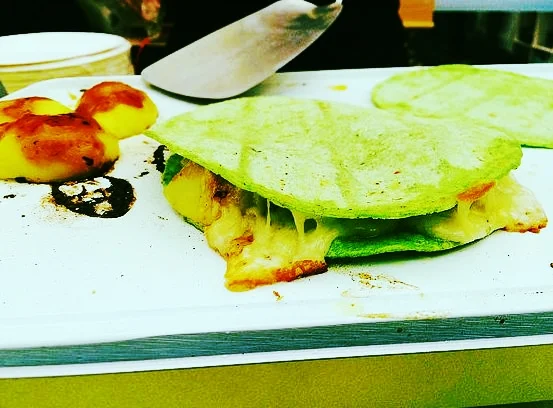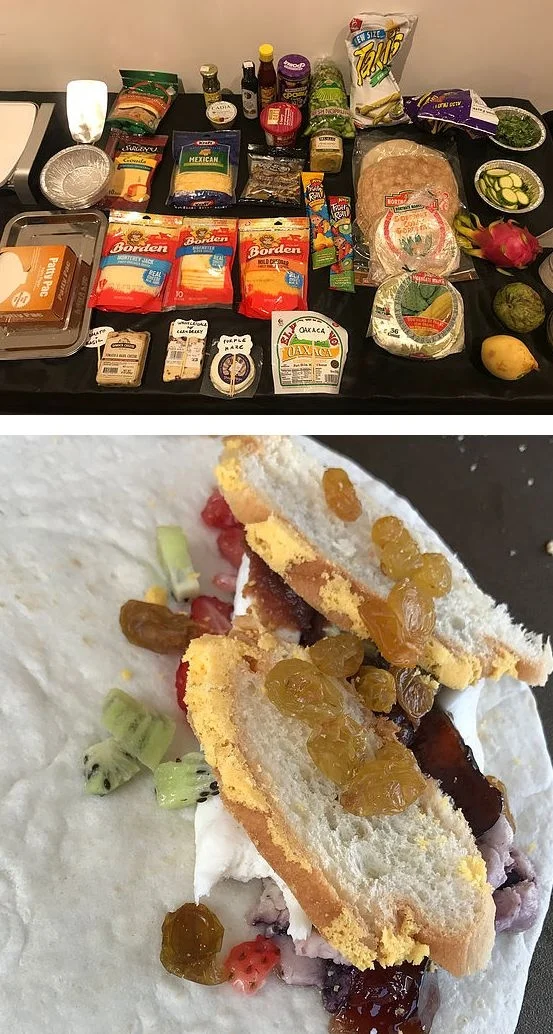BY MONIQUE QUINTANA
I recently had the opportunity to attend Teresa Flores’s Experimental Quesadilla Lab, where I was inspired by the intersections of food, politics, and post-colonial discourse. I learned a lot about myself by sharing with others and taking time to reflect on how integral food is to communal wellness. Here Flores talks about her project and how we can move forward by reflecting on the things that have sustain our selves and those that can before us.
Monique Quintana: Can you tell us a bit about yourself? What is your educational background and what are your research interests?
Teresa Flores: The question I’m still figuring out the answer to first, eh? I can tell you I grew up in Fresno, but I was born in the Inland Empire and we came up north when I was two. My parents, grandparents and even some of my great-grandparents and ancestors are all from the Inland Empire.
My area of study at Fresno State was drawing and painting but I also began to get really curious about video, performance, and the Feminist Art Program that Judy Chicago founded there in the early 70s. After my BA, I moved on to study at Otis College of Art and Design in the Public Practice MFA Program under Suzanne Lacy, who is also one of the artists from the Feminist Art Program. Public Practice got me thinking about art in the most exciting ways and reinforced to me that making art from a personal place is deeply political. So my research interests actually tie into your first question of the ways I identify myself (a Chicana who loves cheese slathered on Mexican food, a woman with chronic illness who shouldn’t eat that much cheese, a feminist who got a ‘C’ in Women’s Studies), and looking at the larger scope of the varying complexities of folks who also hold those identities.
Teresa Flores
MQ: I had such a fun time at the Experimental Quesadilla Lab you hosted at Fresno City College. I loved the interactive and politicized aspect of creating, consuming, and reflecting on food. What specifically inspired this project?
TF: I’m glad you had a fun time while you were taking in all of those politics! Moving to LA for grad school was total culture shock for me. Everything seemed so fancy! There was always a plate of snacks and brie placed in front of us and I was so grossed out by the brie. It had a thick white crust around it and I had no idea how to eat it or why anyone would in the first place. “It smelled like the rotten carpet in a JC Penny’s fitting room”, is how I described it in my thesis. (Shout out to the JCP Juniors Department in Fresno!)
Brie turned out to be my “gateway cheese.” I picked out a crumbly cheese with blueberries at Trader Joe’s one day, but I had no idea what to do with it, so I folded it into a corn tortilla and melted it down. That’s when my cultural conscience hit me with all kinds of questions-- Why would anyone put this weird cheese into a quesadilla? Is this healthier for me because there’s blueberries in it? What would my grandparents say? What would my students in Fresno say?
I thought these were important questions to ask in a public setting and so that’s when the Experimental Quesadilla Lab was born. Many of us are already creating variations on recipes in the privacy of our own homes, and it’s not a big deal. But when those variations make it into public spaces, they’re often presented as gourmet and come at a higher price. I wanted to talk about what it means to take a food like the quesadilla, a product of the colonization of the Americas, and change the ingredients to adapt to accessibility, dietary restrictions, food allergies, and taste preference. I think it's important to have these conversations, especially when you consider California’s history and identity as a cultural bellwether.
Via Flores
Via Flores
Via Flores
MQ: Can you describe an enlightening moment you’ve had in one of your labs? What did it reveal to you about the project and its audiences?
TF: A student at Fresno City College folded his quesadilla into a hexagon. Nobody had done that in the lab before and it made sense considering how much he loaded onto the thing. He was making the tortilla work for him as he needed at that moment and that’s what tortillas are supposed to do. It reinforced what we already know about young folks-- they’re more inclined to experimenting. But it also revealed to me the significance of leaving room for folks to really assemble their quesadilla to their liking and see the comal as another part of the process of visual self-expression through food. I would like to do more of that in the future which means slowing down the labs and that’s exciting to me.
Via Flores
MQ: I really admire how your projects cultivate public wellness and education through art. What advice would you give to other artists applying for project grants? What kind of things should they discuss in their proposals?
TF: I’d say just go for it. Type the proposal all out the first time around even if it sounds crazy and then edit from there. Show it to folks who are familiar with the grant process and get their feedback on ways to keep your project practical. If you’re partnering with a non-profit, make sure your vision is in line with theirs. That way no one’s surprised when you start talking about Chicano history or something like that.
It’s important to keep in mind the bigger picture of what your project is about and how it fits into the current discourse of whatever it is that you’re proposing to do. Do a little research and ask around and see if there have been projects similar to yours and let the grant funders know why yours is important to the discourse.
Via Flores
MQ: What kind of projects and events would you like to work towards in the future?
TF: I’m digging deeper into California identity, migration and immigration. I’m also dabbling back into studio practices because I feel out of balance when I don’t draw or make objects after a certain amount of time. I would like the lab to keep growing but I also want to keep experimenting with formatting by slowing it down and making it smaller from time to time.
MQ: Would you like to give any other multimedia artists/activists you’d like to shout out? Who should our readers be following?
TF: Adrianna Alejo Sorondo, La Loba Loca, and April Bojorquez and Matt Garcia with @desertartlab. They’re all doing great work looking at practices of healing, intersections between the rural and the urban in California and the Southwestern US, and they’re always sharing cool aspects of their daily lives on the IG.
Teresa Flores is an interdisciplinary artist based in Los Angeles. Her work examines identity and wellness and includes drawing, video and social practices. Flores has presented at the Museum of Contemporary Art San Diego and Spike Art Quarterly in Berlin and her work has exhibited in The Ural Industrial Biennial of Contemporary Art. She has taught Visual Culture at California State University Fresno and currently teaches for the Amory Center for the Arts. She holds an MFA in Public Practice from Otis College of Art and Design and most recently completed a fellowship with The Woman’s Building in Los Angeles.
Monique Quintana is a contributing editor at Luna Luna Magazine, and her work has appeared in Huizache, Bordersenses, and The Acentos Review, among other publications. She is an alumna of the Community of Writers at Squaw Valley and the Sundress Academy of the Arts and has been nominated for Best of the Net. She blogs about Latinx literature at her site, Blood Moon and is a pop culture contributor for Clash Media.






































